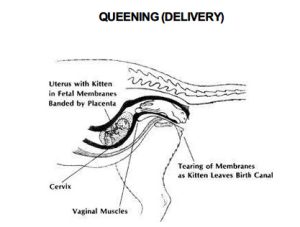DELIVERY
A week or two prior to parturition (delivery) some queens may become restless and search for a nesting area. Even if there are no behavioral changes, you will usually be able to detect rapid enlargement of the mammary glands in the week before delivery. Milk (colostrum) can usually be expressed from the nipples within forty-eight hours of delivery. In some cats the rectal temperature drops for a short time around twelve to thirty-six hours before delivery from the normal 101 to 102°F (38.3 to 39.2° C) to as low as 98°F (36.7°C). However, this is not a reliable sign, and it is necessary to watch for others that more accurately signal the impending birth.
Usually a day or two before delivery the queen will lose her appetite, become anxious and more vocal than usual, and begin to shred the materials used for lining the nest box. She may even vomit. As delivery becomes even closer, she usually licks frequently at the abdominal and genital areas. If you have failed to adjust the female to the kindling (kittening) area, your cat may try to nest in your bed, in a closet, or in some other unsuitable spot. Encourage her to remain near the maternity box and stay with her until she becomes comfortable. It is not necessary for the queen to actually be in the box, as mild exercise during the first stages of labor and between kitten deliveries actually helps the process. If she seems particularly distressed about using a designated nest box, however, it is best to let the queen nest where she is most comfortable since emotional stress can inhibit or terminate labor. Queens often move their kittens after delivery, so it is not usually a problem for you to allow them to be delivered in one spot, then move them to a new, more suitable one, once delivery is completed.
During the first stage of labor the female kneads and rearranges the bedding and may even pull hair from her body in her attempt to make a nest. Rapid breathing (sometimes panting) and trembling are often seen, and her pulse rate will increase. Frequent changes of position are made; colostrum may drip from her nipples, and bloodtinged discharge may appear at the vaginal opening. Uterine contractions moving the kitten from the uterine horn to the body of the uterus and the cervix are occurring during this first stage, which may last twelve to twenty-four hours. A long first stage is particularly characteristic of a first pregnancy. If the signs last more than a day, if the vaginal discharge is foul smelling or consists of large quantities of pure blood and/or blood clots, or if your cat seems to pass into the second stage then back to the first, or seems unusually uncomfortable, discuss the matter with your veterinarian before assuming everything is all right.
During the second stage of labor you will see forceful straining movements caused by the simultaneous contractions of the abdominal muscles and the diaphragm. At the beginning of this stage you may see a small amount of straw-colored or greenish fluid passed at the vulva. This is due to the rupture of the allantois-chorion (the protective membrane that covers the kitten) as it passes into the vaginal canal. It may take as long as an hour for a kitten to be delivered once the second stage begins. The female may lie on her side or on her sternum (chest), or she will stand and squat as if she were going to have a bowel movement during the most vigorous portions of straining. The amnion (membranous sac) enclosing the head of the kitten sometimes appears at the vulva. It may, however, be ruptured before the kitten is delivered. Once the head and paws of the kitten appear, complete delivery should be finished within fifteen minutes— if not, call your veterinarian. The nose and feet of the kitten should not appear and disappear each time the female strains. In the classic birth position the kitten is delivered with its sternum on the vaginal floor, nose first and its front paws along the sides of its face. Nearly half of all kittens, however, are delivered rear legs first. This usually causes no problem.
As soon as a kitten is delivered, the amniotic sac (amnion) should be broken to allow the kitten to breathe. Cats are normally very good mothers and usually do this immediately, but inexperienced or nervous females may not. If this is the case, you must break the amnion or the kitten will suffocate. However, if the umbilical cord is not broken during delivery, it is not necessary to break it immediately. Significant amounts of blood are found in the placenta, and by allowing the umbilical cord to remain unbroken, you allow time for this blood to pass into the kitten. Normally the mother nips the umbilical cord and breaks it as she cleans and licks the kitten following delivery. If she doesn’t do this after about fifteen minutes, a clean piece of thread or unwaxed dental floss should be tied around the cord about one-half to one inch from the body wall. The cut or break the cord just beyond (distal to) the tie and dip it briefly in povidone-iodine disinfectant solution. If the mother has a tendency to bite the cords very near the kitten’s abdominal wall, you should prevent this and cut the cord yourself, as very short umbilical cords become infected much more often than those of a more usual length.
PREVENT UMBILICAL INFECTION
If you have a kitten with a short cord prompt treatment with antibiotics given by your veterinarian will usually prevent umbilical cord infection, a common cause of death in young kittens. Examine the umbilical area for evidence of swelling, discoloration, or drainage that may indicate infection.
Untreated infections can easily cause death within three days.
Normally, the placenta (afterbirth) is delivered with or just after the kitten.
It is a good idea to count the placentas as they are delivered to be sure all are passed. Retained placentas can cause uterine inflammation and infection. It is normal, but unecessary, for the female to eat the placenta following each delivery. It is best to let the queen eat only one or two; the ingestion of too many can cause vomiting and diarrhea.
The time of delivery of the placenta and the period of uterine rest that follows each kitten is the third stage of labor. During the rest period the queen often lies still and tends her kittens. Some queens will get up and move about; this can actually help speed delivery. The rest period between kittens varies from about ten to fifteen minutes to several hours. It is not usually more than one to two hours, however. Average-sized litters for cats range from three to five kittens, but as many as fourteen have been delivered and survived! Average delivery times range from about two to six hours. Normal parturitions, however, may take longer than six hours. Some last up to twenty-four or even thirty-six hours, but deliveries lasting longer than this are considered abnormal even though kittens have survived when delivered over a period of three days.

